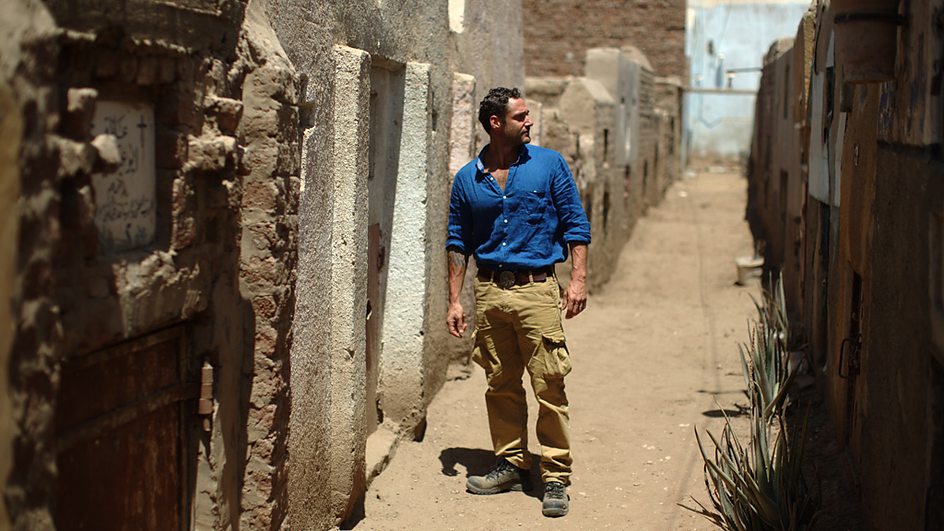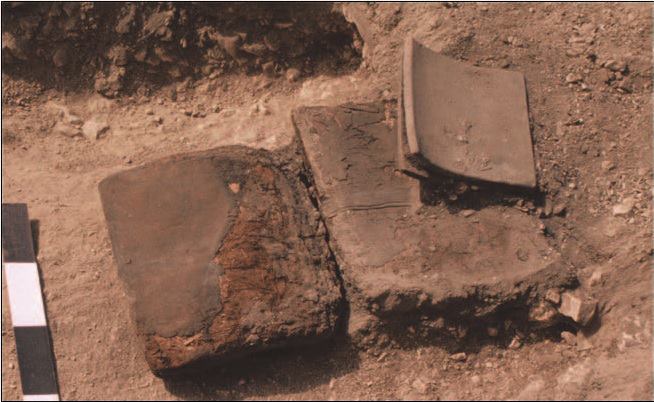Assessing BBC2’s The Bible Hunters
The two-part BBC2 documentary “The Bible Hunters” has generated some discussion among bloggers recently, due particularly to participating-scholar Larry Hurtado’s criticisms of the show. I was finally able to watch the series over the last few days (it has not yet aired in North America) and thought I would make some comments, particularly about the second episode in the series, “The Search for Lost Gospels.”

“The Bible Hunters” is hosted by Jeff Rose, described in his profile as “an archaeologist and anthropologist specializing in the prehistory, palaeoenvironments, genetics, and religious traditions of the Middle East.” Throughout the series he visits (on foot, by boat, by camel, and by motorcycle) a number of Middle Eastern sites related to important biblical and non-biblical manuscript discoveries—including St. Catherine’s Monastery on Mount Sinai, Akhmim, and the White Monastery in Sohag. In each location he interviews scholars and monks about the manuscripts, and then places the discoveries into the context of 19th/20th-century debates about the authenticity of the Bible. A number of British scholars help Rose elucidate the discoveries and their impact, including David Gange (University of Birmingham), Edward Adams (King’s College, London), and Michael Ledger-Lomas (King’s College, London); American Kent Clark (Trinity Western University) also makes an appearance. The deficit of women’s voices is apparent—Janet Soskice is the exception, included to comment on the Smith sisters, whose careers are documented in Soskice’s book The Sisters of Sinai (discussed HERE).
The first episode, “The Search for Bible Truth,” follows the exploits of such “Bible Hunters” as Constantin von Tischendorf (known for his discovery of Codex Sinaiticus), the Smith sisters (Codex Syriacus), and Charles Freer (the Washington Codex). The narrative that guides the episode—that these intrepid scholars and collectors were seeking manuscripts to demonstrate the accuracy of the Bible—has been criticized by Hurtado (HERE); in reality, they were trying to find manuscripts to reconstruct a better Bible. The narrative is simplified further with its focus on the troublesome ending of Mark—shortened in Sinaiticus and Syriacus, but uniquely expanded in the Washington Codex. Nevertheless, this simplification provides useful focus to the documentary, one easily digestible to its lay audience.
The second episode, “The Search for Lost Gospels,” is presented much like the first, with Rose making his way south through Egypt, stopping at sites related to the discovery of apocryphal texts. Rose begins at Oxyrhynchus, with the discovery of the “sayings of Jesus” papyri that were later identified as pieces of the Gospel of Thomas. The discussion of the find is accompanied by on-site video, recent high-quality photographs of the manuscripts, and nineteenth-century photographs of the excavations. The discovery is put in context by Charles Freeman, author of A New History of Early Christianity; he focuses on the traditions of Jesus’ death, burial, and resurrection and how, it is believed, these were put in written form when the apostles were dying one-by-one and thus could no longer be a source for oral traditions about Jesus. But now, along comes these lost sayings of Jesus, demonstrating that there were other teachings by Jesus outside of the New Testament. “For almost 2000 years,” Rose says, “[the New Testament gospels] had the monopoly on the story of Jesus.” Well, that’s not true. There were plenty of apocryphal texts known before the discovery of the Gospel of Thomas—including a plethora of infancy gospels that added much to the “story of Jesus.” But, granted, none of them present potential teachings of the Historical Jesus in quite so dramatic a way as Thomas does.
The episode turns next to a digression on the impact on Biblical Studies made by the opening of the East beginning with Napoleon in the late 18th century. The Temple of Denderah is shown, with its zodiac demonstrating an antiquity to civilization counter to Ulster’s “young Earth” chronology, and later there is a discussion of the Egypt Exploration Society and the discovery of the Amarna letters. This material seems out-of-place in the documentary and one wonders if it was intended originally for an episode all its own.
The next site of interest is the Syrian Monastery (Deir el-Surian; mentioned recently HERE) visited by Robert Curzon in 1883. Curzon brought dozens of manuscripts from the library back to England with him; they are held now in the British Library. One of these manuscripts is the Acts of Peter and Paul, which Rose calls “a text no-one had seen before.” He asks “ why was this not included in the Bible?” The Acts of Peter and Paul is an odd example to use here. Numerous other, and more interesting, texts were found at el-Surian, including a very early manuscript (Add. 14484) combining the Infancy Gospel of James, the Infancy Gospel of Thomas, and the Dormition of Mary. And to ask why the Acts were not included in the Bible is odd, given that it is a rather late text (fifth century), especially compared to the infancy gospels.
Curzon traveled on from Deir el-Surian to the White Monastry in Sohag, and Rose follows him there. While Curzon is said to have found nothing significant at the White Monastery, later Bible hunters came across a hidden library that included the Book of the Resurrection of Jesus Christ, by Bartholomew the Apostle (mistakenly called the Questions of Bartholomew in the documentary). The manuscript for this text is dispersed in several European libraries; the image shown here is Ms 1991 of the Schøyen collection. Again, much is made of the discovery of this text, but its real impact was rather negligible. Numerous other White Monastery discoveries hold greater interest. Alin Suciu has made great advances recently in bringing the pages of these manuscripts together. It is unfortunate that this work was not featured in the documentary.
The next site that Rose visits is Akhmim, where, in 1886 French archeologist M. U. Bouriant discovered in the necropolis of a Christian monk a book containing excerpts from 1 Enoch, the Gospel of Peter, and the Apocalypse of Peter. Rose says of this discovery, that the Gospel of Peter was the “first gospel to appear in print not in the New Testament,” which, of course, is not true. Certainly it was a significant find, but it should have been put in better context (indeed, the earlier discussion of the Passion and Resurrection of Jesus belongs here, not with the Gospel of Thomas). Still, it was interesting to watch Rose search through the Akhmim cemetery, and we are given a look at the type of tomb in which the codex was found.
Rose then turns his attention back to Oxyrhynchus for a more in-depth discussion of the manuscript discoveries with Dirk Obink, the head of the Oxyrhynchus Papyri Project. Now the sayings from the Gospel of Thomas are placed in their more appropriate context; unlike the Acts of Peter and Paul and the Book of Bartholomew, the Oxyrhynchus sayings did make a big impact on scholarship and public thinking. People did wonder if these were real teachings of the Historical Jesus excluded from the Bible. The Gospel of Thomas provides a useful segué to the next site: Nag Hammadi, where the “mystery of the Oxyrhynchus sayings was solved” with the discovery of the Coptic Gospel of Thomas. Egyptian guide Ahmed M. Abul Ella Ali discusses the find and Larry Hurtado declares that the texts at Nag Hammadi have an “elitist outlook” (a perspective that has led to some criticism from April DeConick). The Gospel of Philip is mentioned as a text that “might have seemed scandalous” because of its mention of the kiss exchanged between Jesus and Mary Magdalene, but there is no scholarly discussion of this passage. Also given some attention is the Gospel of Mary, erroneously identified as a text discovered at Nag Hammadi, and what it might tell us about women’s roles in early Christianity.

Finally, we come to the last site on the tour: a hermitage at Sheikh el-Gurna in Upper Egypt excavated in 2005. Here the grave of a Christian monk yielded a 9/10th-century Coptic codex containing Isaiah and fragments of the Martyrdom of Peter (here called the Acts of Peter and said to be similar to the Acts of Peter and Paul found by Curzon). The discovery has not received much attention in scholarship, despite the Egyptian Supreme Council of Antiquities’ hyperbolic statement that “the finds are equal in importance to the Naga Hammadi manuscripts.”
In all, the Bible Hunters is an excellent series, rich in archeological detail, manuscript images, and on-site journalistic inquiry. Though it suffers from the occasional factual error and distortions from both simplification and exaggeration, it presents the information far better than its sensationalist North American counterparts. It is unfortunate, however, that the producers could not include opinions of local experts on the literature—including J.K. Elliott, Christopher Tuckett, and Andrew Gregory. Instead we get an Egyptian guide (Ali) and the author of a book on early Christianity (Freeman). Neglected also is the Bodmer Papyri, a cache of texts found at Dishna, not far from Nag Hammadi, that includes significant Biblical Mss as well as several Christian Apocrypha, including very early copies of the Infancy Gospel of James, the Acts of Paul, and 3 Corinthians. This is an astonishing oversight.
The value of documentaries like Bible Hunters is in their use in the classroom. In the Fall, I will be looking for ways to integrate the series into my classes on the History of the Bible and the Christian Apocrypha.

thanks for the 2005 Martyrdom of Peter discovery correction.
Jeff Rose is somewhat less than honest in his characterization of Christian (specifically Catholicism). The literal belief of Genesis is quite soundly refuted by St. Augustine’s in his treatise on Genesis as being mostly figurative language. See http://college.holycross.edu/faculty/alaffey/other_files/Augustine-Genesis1.pdf
If the producers are unaware of this they are displaying a remarkable ignorance. If they are aware of this they being intentionally deceptive malicious.
Hi Tony Burke,
Possible typo.
“The next site of interest is the Syrian Monastery (Deir el-Surian; mentioned recently HERE) visited by Robert Curzon in 1883. ”
Robert Curzon (1810-1873)
https://en.wikipedia.org/wiki/Robert_Curzon,_14th_Baron_Zouche
Looking to share with you NEW information on Codex Sinaiticus! 🙂
Thanks Steven.